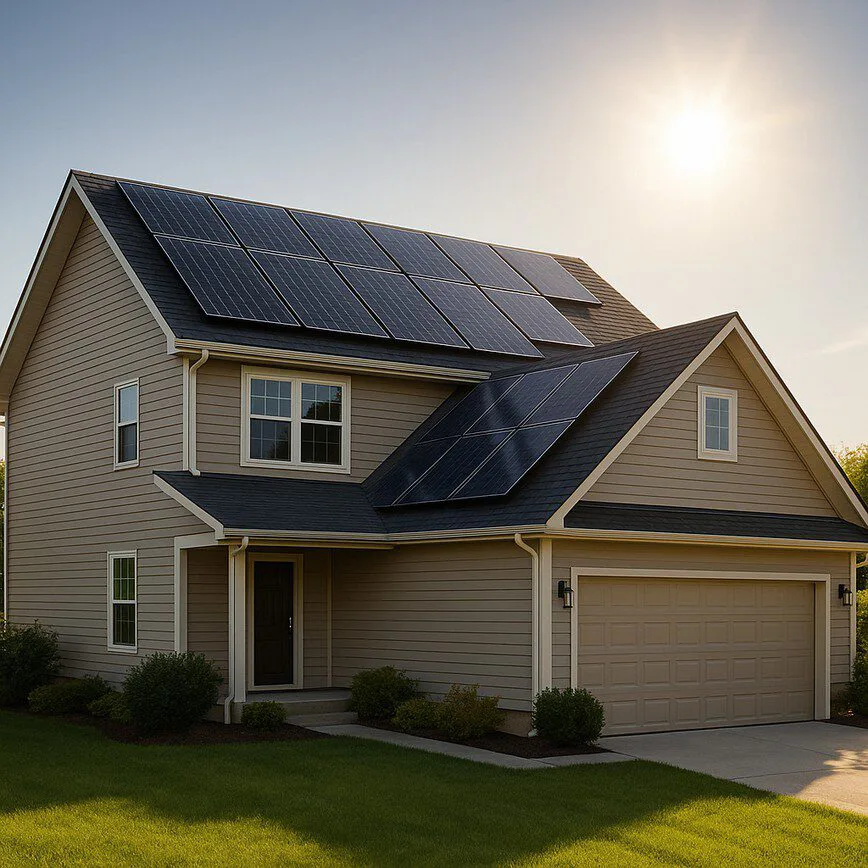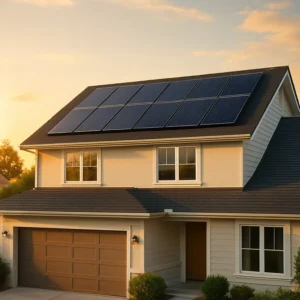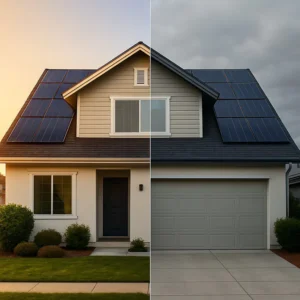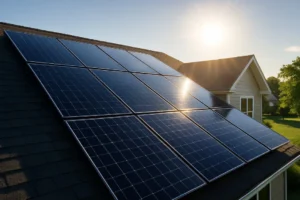One of the first and most common questions homeowners ask when considering a switch to clean energy is, “How many solar panels do I need?” It’s a crucial question that directly impacts the cost, efficiency, and return on investment of your system. While many people look for a simple answer based on their home’s size, the reality is a bit more nuanced.
Table of Contents
- The Simple Answer: It’s Not About House Size
- Your Solar Panel Sizing Guide: 3 Key Factors
- Putting It All Together: The Sizing Formula
- Example: How Many Solar Panels Does a 2000 sq ft House Need?
- Beyond the Panels: Sizing Your Whole System
- Ready to Find Your Number? Use Our Solar ROI Calculator
- Making an Informed Decision with Confidence
The good news is that you don’t need to be an engineer to get a reliable estimate. As a central part of our comprehensive solar knowledge base, this guide will walk you through the key factors that determine your needs. We’ll break down the calculations and provide clear examples so you can approach your solar journey with confidence.
The Simple Answer: It’s Not About House Size
It’s a common misconception that the number of solar panels you need is directly tied to the square footage of your home. While a larger home may use more electricity, it’s not a given. A small, energy-intensive household could easily require more panels than a large, energy-efficient one.
Instead of focusing on size, the correct approach is to focus on three key variables:
- Your electricity consumption.
- The amount of direct sunlight your roof receives.
- The wattage and efficiency of the solar panels you choose.
Let’s dive into each of these.
Your Solar Panel Sizing Guide: 3 Key Factors

1. Calculate Your Annual Energy Consumption
The single most important factor is how much electricity your home uses. This is measured in kilowatt-hours (kWh). The easiest way to find this is by looking at your past utility bills.
Most electric companies provide a summary of your usage over the last 12 months. Look for a “Total kWh Used” or similar figure. If you can only find monthly numbers, simply add them together to get your annual total. Knowing this number is the foundation for sizing a system that meets your specific residential needs.
Example: If your bills show you used 900 kWh in January, 800 kWh in February, and so on, you would add all 12 months up. Let’s say your annual total is 11,000 kWh.
2. Determine Your Area’s Peak Sun Hours
Not all sunlight is created equal. “Peak sun hours” refers to the average number of hours per day when the sun’s intensity is strong enough for your panels to generate their rated power. This isn’t just the number of daylight hours; it accounts for the sun’s angle, weather patterns, and time of year.
This number varies significantly by location. A home in Arizona will have more peak sun hours than one in Washington. You can find reliable data for your specific area using maps from the National Renewable Energy Laboratory (NREL). On average, most places in the U.S. get between 4 and 6 peak sun hours per day.
3. Understand Solar Panel Wattage and Efficiency
Solar panels turn that sunlight into energy through the photovoltaic effect, where solar cells convert sunlight directly into DC (direct current) electricity. The amount of electricity a single panel can produce is measured in watts (W).
Residential solar panels typically range from 300W to 450W. A higher-wattage panel will produce more energy under the same conditions, meaning you will need fewer of them to reach your energy goals. While more efficient panels might have a higher upfront cost, they can be a great solution for homes with limited roof space.
Putting It All Together: The Sizing Formula
Once you have your three key numbers, you can get a solid estimate of how many panels you need.
Here’s the basic formula:
Number of Panels = Annual Energy Usage (kWh) / ( (Panel Wattage * Peak Sun Hours * 365) / 1000 )
Let’s use our example from above:
- Annual Usage: 11,000 kWh
- Peak Sun Hours: 5 per day
- Panel Choice: 400W panels
Number of Panels = 11,000 kWh / ( (400 W * 5 hours * 365 days) / 1000 )Number of Panels = 11,000 / (730,000 / 1000)Number of Panels = 11,000 / 730
Result: Approximately 15 panels
Example: How Many Solar Panels Does a 2000 sq ft House Need?
Let’s address this common long-tail question directly. As we’ve established, square footage isn’t the main factor, but we can create a realistic scenario.
The average U.S. household uses about 10,600 kWh per year. Let’s assume our 2000 sq ft house fits this profile and is located in an area with 4.5 peak sun hours per day. We’ll use 375W panels.
- Annual Usage: 10,600 kWh
- Peak Sun Hours: 4.5 per day
- Panel Choice: 375W panels
Number of Panels = 10,600 kWh / ( (375 W * 4.5 hours * 365 days) / 1000 )Number of Panels = 10,600 / (615,187.5 / 1000)Number of Panels = 10,600 / 615.19
Result: Approximately 17-18 panels
This calculation shows that for an average home of that size, you’d likely need between 17 and 18 panels. However, your personal energy habits are what will truly define your needs.
Beyond the Panels: Sizing Your Whole System
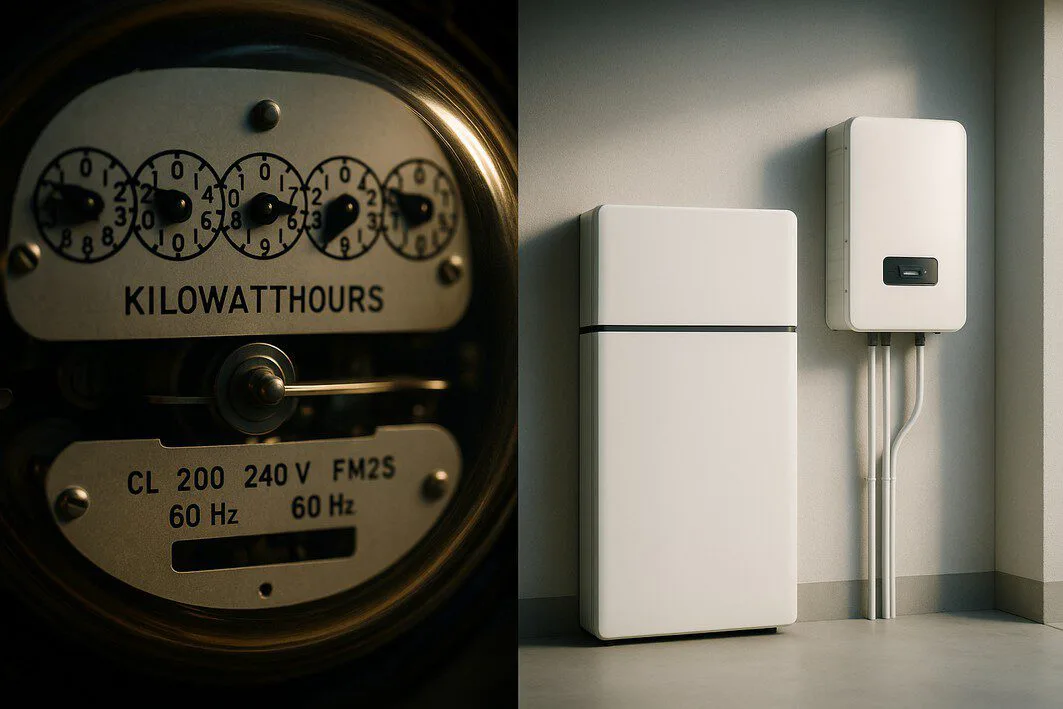
Remember, solar panels are just one part of the equation. A complete residential solar solution also includes inverters (to convert DC to usable AC power), mounting hardware, and potentially a battery for energy storage. Making the right choice for these components is just as important as selecting the panels. For a deeper dive, our guides are an excellent resource for choosing the right solar products and components.
Ready to Find Your Number? Use Our Solar ROI Calculator
While this manual guide gives you a fantastic starting point, a dedicated tool can provide a much more precise and personalized analysis. To truly understand your potential savings and system size, the next step is to use a calculator.
RenewGenius offers a powerful ROI calculator to help you make an informed decision. By inputting your address and average electric bill, our tool can:
- Instantly estimate the number of panels you need.
- Calculate your long-term savings.
- Show you your potential return on investment.
It’s the fastest and most accurate way to get the answers you need for your specific home.
Making an Informed Decision with Confidence
Determining how many solar panels you need is the first step toward energy independence. By focusing on your actual energy consumption rather than just your home’s size, you can build a system that’s perfectly tailored to your lifestyle.
At RenewGenius, we are committed to providing a comprehensive knowledge base to empower homeowners like you. Use the information in this guide and our powerful tools to move forward in your solar journey with confidence.

